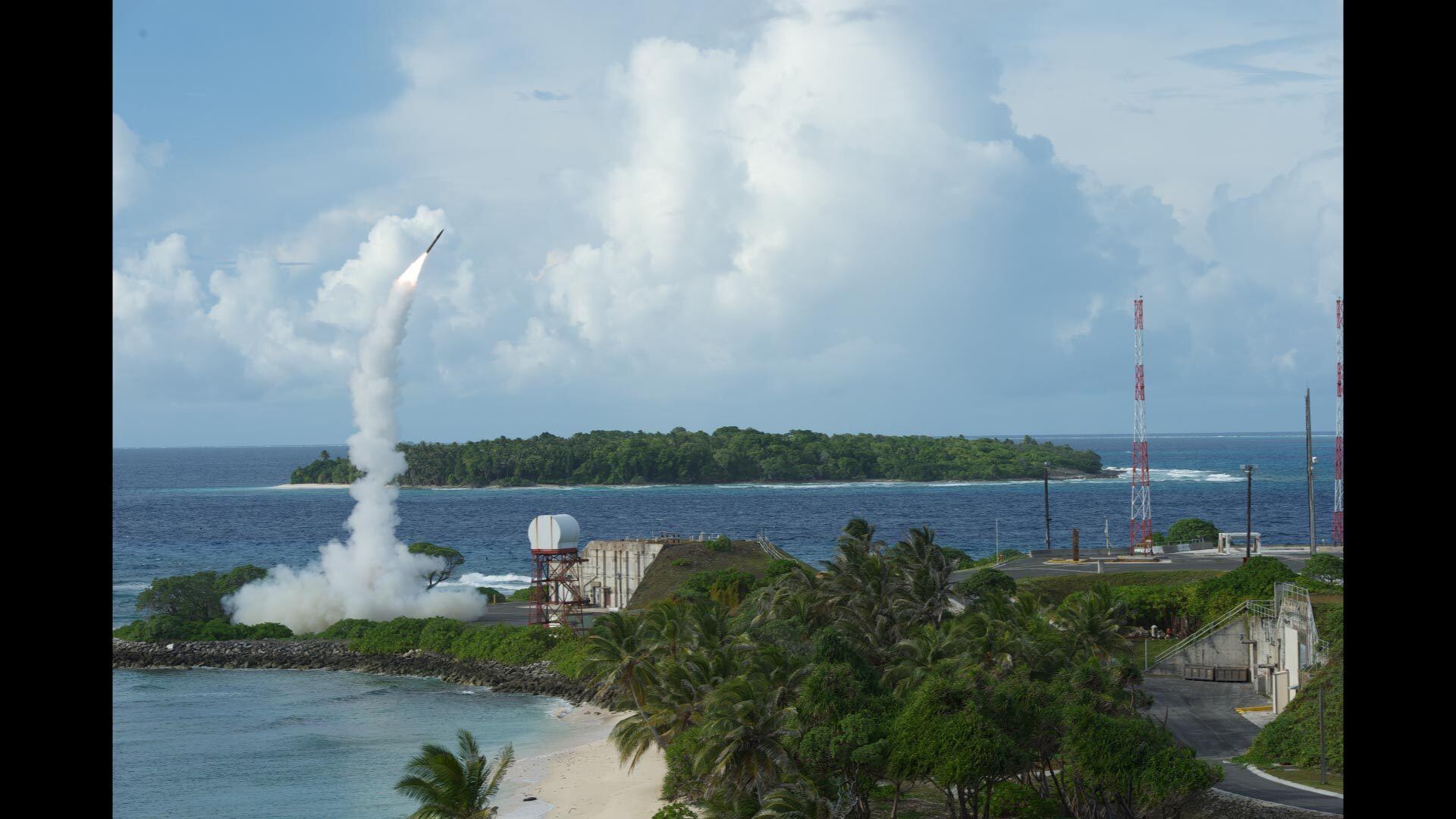WASHINGTON — America’s focus on countering intercontinental ballistic missiles is broadening to cruise and hypersonic missiles, and modest spending might not cut it.
Analysts and experts are hoping the fiscal 2024 budget request will prove the Biden administration is committed to a layered homeland missile defense architecture.
Acknowledging the growing array of missile threats, the Trump administration in 2019 removed “ballistic” from its description of homeland missile defense when it released its Missile Defense Review. The Biden administration has not yet released an unclassified version of its review.
But John Plumb, the first-ever assistant secretary of defense for space policy, testified in May before the Senate Armed Services Committee’s strategic forces panel that while China is the pacing threat in terms of military strategy, Russia’s invasion of Ukraine emphasizes the need for a broader missile defense strategy for the homeland.
“The sobering reality of the tragic events in Ukraine, in which Russia has used and continues to use a broad array of missiles to attack and, in my opinion, terrorize civilian populations, highlights the extent to which our adversaries are prepared to use missiles in a conflict,” Plumb said. “Missile defenses are critical for defending the U.S. homeland and for defending our deployed forces and our allies and partners.”
Plumb noted the FY23 budget request called for “significant investments in homeland missile defense,” including $2.8 billion to develop the Next Generation Interceptor and for the service-life extension of the Ground-based Midcourse Defense system as well as $4.7 billion to transition to a “resilient missile warning and missile track satellite architecture.”
It also sought $4.7 billion for the Space Force, $278 million for new over-the-horizon radars to enhance the ability to detect cruise missile attacks on the homeland and nearly $1 billion for missile defense capabilities for Guam.
Development focus
The Missile Defense Agency has several efforts underway to address a wider variety of threats. One priority is ensuring the Ground-Based Interceptors in the Ground-based Midcourse Defense system are replaced by the Next Generation Interceptor.
While Ground-Based Interceptors only have one kill vehicle, allowing each to destroy a single intercontinental ballistic missile in flight, the Next Generation Interceptor is undergoing designs to house multiple kill vehicles, making it possible for one interceptor to simultaneously defeat several incoming missiles.
Northrop Grumman and Raytheon Technologies are competing against a team of Lockheed Martin and Aerojet Rocketdyne to design the Next Generation Interceptor. The Missile Defense Agency hopes to place the first future interceptor into a ground-based silo by 2028.
MDA is also using a competitive development strategy to develop a Glide Phase Interceptor capable of defeating a hypersonic weapon. Raytheon Technologies and Northrop Grumman were selected in June to continue developing the interceptors.
The agency will first focus on providing a capability to the Navy and, if successful, move to develop a land-based battery.
Meanwhile, the agency and U.S. Northern Command are working together to test a possible cruise missile defense capability for the homeland. They plan to conduct a capability demonstration in FY23 that integrates an elevated sensor into a so-called joint tactical integrated fire architecture with fire control for a naval long-range surface-to-air interceptor.
A major endeavor for MDA in the coming fiscal year is to kick off construction of a missile defense architecture in Guam. The agency set an FY26 fielding deadline for the capability and plans to spend $539 million in FY23 to begin the process.
The architecture will be mobile and include Navy SM-3 and SM-6 missiles, the Patriot air defense system, and the Army’s Terminal High Altitude Area Defense System. The U.S. has operated that latter battery in Guam since 2013.
Those elements are to connect through the Army’s Integrated Battle Command System — command-and-control technology that connects sensors and shooters on the battlefield. The agency will also use the Aegis weapon system’s fire control capability.
Pentagon officials have said the architecture on Guam could serve as a proof of concept or a test bed to contribute to a homeland cruise missile defense architecture.
Money for missile defense
The Pentagon has said it budgeted roughly $20 billion to develop a “missile defeat” capability. This figure appears to be a big boost, Robert Soofer, who served as deputy assistant secretary of defense for nuclear and missile defense policy during the Trump administration, told Defense News.
But only about half of that funding will go toward traditional missile defense, Soofer noted. Some of the funding, for example, is for offensive hypersonic weapons development — an area set to receive about $3.8 billion in the FY23 request.
MDA requested $2.8 billion to continue to sustain and upgrade its Ground-based Midcourse Defense system, and $225 million to develop the Glide Phase Interceptor to counter hypersonic threats.

A total of $89 million would pay for delivering space vehicles for launch vehicle integration as well as complete development of the ground system for the second quarter of FY23, which will see the launch of two prototypes and on-orbit experimentations of the Hypersonic and Ballistic Tracking Space Sensor.
Congress is also moving to increase missile defense development funding in its FY23 defense authorization bills. The Senate Armed Services Committee released its version of the bill in July, which included $50.9 million in additional money for the cruise missile defense for the homeland demonstration.
The committee also doubled the Glide Phase Interceptor weapon account to $518 million.
For its part, the House Armed Services Committee in its version of the FY23 National Defense Authorization Act approved $166 million in additional funding — more than double the request — for continued development of the Hypersonic and Ballistic Tracking Space Sensor.
Capitol demands
Both chambers’ versions of the FY23 authorization bill indicate Congress wants increased oversight and a better sense of who will manage missile defense programs.
The Senate version of the bill calls for a “rapid and complete modernization of legacy nuclear capabilities of the United States and the timely development of a range of ballistic, cruise, and hypersonic boost glide missiles.”
Senators ask for increased notification and reports, should the Pentagon run into issues that could delay or prevent the fielding of those critical capabilities. The legislation also requires Pentagon officials brief Congress twice a year on missile defense policies, operations and technology development.
Additionally, members of the Senate Armed Services Committee want the defense secretary to designate a senior Defense Department official to oversee the missile defense of Guam within 90 days of the bill’s passage.
The House version of the bill acknowledges the White House’s FY22 and FY23 budgets make “a needed and significant shift” to address missile tracking and warning architecture. The legislation also notes the Pentagon should continue to fund and deliver the capability from low Earth orbit in the mid-2020s.
Lawmakers also require the defense secretary and MDA to submit a comprehensive layered strategy to use “asymmetric capabilities” to defeat hypersonic missile threats.
Members of Congress appear to be backing off from a push to fund a homeland missile defense radar in Hawaii. MDA has not included funding for the radar for several years, but Congress had added funding the last several budget cycles to move forward on the program.

However, in the latest House Armed Services Committee bill, lawmakers noted they will wait to determine what’s needed in Hawaii until learning more about a review currently in the works by the Pentagon on the integrated air and missile defense sensor architecture of U.S. Indo-Pacific Command.
House lawmakers have also been pressuring the Pentagon to designate a department or agency to lead its homeland cruise missile defense efforts. Deputy Defense Secretary Kathleen Hicks in late July gave the Air Force lead acquisition authority over homeland cruise missile defense.
A memo from Hicks gives the Air Force 180 days to deliver a plan and proposed architecture that addresses meeting homeland cruise missile defense capability gaps “projected in Fiscal Year 2026 and 2030.”
‘We don’t really get a choice’
But some analysts and experts say the shift toward thinking about missile threats more broadly is inevitable.
“We don’t really get a choice about whether or not we go after this,” Tom Karako, a missile defense expert at the Center for Strategic and International Studies, told Defense News. “We have to counter all of these different pieces of the air-and-missile threat spectrum in some way, be it passive defense, be it active defense, be it distributed ops or what have you. That’s just the reality.”
The architecture at Guam will give the Pentagon an opportunity to look at what’s possible, Karako added.
He said he’ll be watching the president’s FY24 budget request for proof the White House is committed to a more robust defense of the homeland. “Will it go after homeland cruise missile defense like we mean it?” he wondered.
If the White House and the Defense Department don’t commit more money to solving the homeland cruise missile defense mission in FY24, “it sends a signal that there are [other], higher priorities,” Soofer said.
North American Aerospace Defense Command and U.S. Northern Command, in consultation with the Missile Defense Agency and the Joint Integrated Air and Missile Defense Organization, are closing in on a design framework for the mission, Brig. Gen. Paul Murray, NORAD deputy director of operations, said last month. The next step is to show decision-makers it will work, he explained.
Bradley Bowman, senior director of the Center on Military and Political Power at the Foundation for Defense of Democracies, told Defense News that “you can tell if an administration is serious by scrutinizing whether they produce well-formulated missile defense acquisition strategies in a timely manner and request the necessary funding to field capabilities as quickly as possible.”
“Too often, we have seen a dissonance between words and actions,” he added. “I worry we will pay a steeper price for that dissonance in the future.”
Jen Judson is an award-winning journalist covering land warfare for Defense News. She has also worked for Politico and Inside Defense. She holds a Master of Science degree in journalism from Boston University and a Bachelor of Arts degree from Kenyon College.








